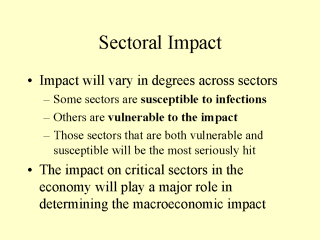| front |1 |2 |3 |4 |5 |6 |7 |8 |9 |10 |11 |12 |13 |14 |15 |16 |17 |18 |19 |20 |21 |22 |23 |24 |25 |26 |27 |28 |29 |30 |31 |32 |33 |34 |35 |review |
 |
Just as
different companies will experience different impacts because of the nature of their
workforce and the benefits they offer, so too, the impact on different sectors varies.
Sectors that are likely to be vulnerable to the impact are those sectors which rely on a
highly skilled labour force, or a labour force that becomes highly experienced through
costly on the job training. However, the labour force is reasonably stable, in that they
are not required to do large amounts of travel, and are based at home with their families.
Any white-collar industry would be an example of a vulnerable sector. Sectors susceptible to infections would include, for example the commercial agriculture sector, where, although there is a large labour-force which would sometimes rely on the migrant labour system, the workers are not particularly highly skilled – or rather, the industry does not invest a lot to train these workers. The mining industry is an example of a sector which is both vulnerable and susceptible. This industry relies on a largely male, predominantly migrant labour force traditionally living in single sex hostels on-site. As such, miners are spending long periods of time away from their families, and are likely to have access to sex-workers. The point is that if certain critical sectors of the economy fail to respond to the threat posed by HIV/AIDS to their employees by offering effective prevention and treatment options, they may well find themselves paying much more than previously to produce the same number of products/services. |
| front |1 |2 |3 |4 |5 |6 |7 |8 |9 |10 |11 |12 |13 |14 |15 |16 |17 |18 |19 |20 |21 |22 |23 |24 |25 |26 |27 |28 |29 |30 |31 |32 |33 |34 |35 |review |